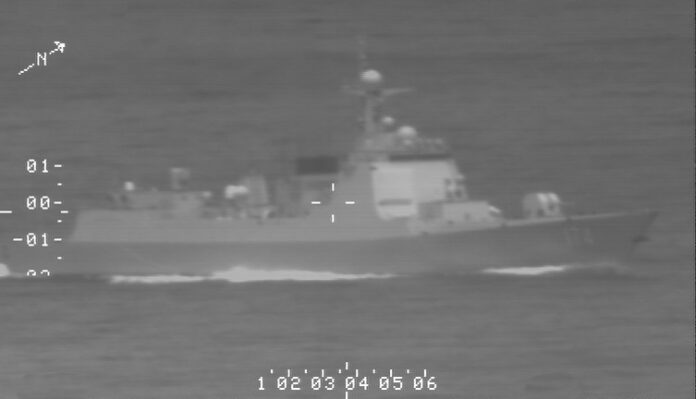
By Peter Layton*
Repeating an aggressive action four times shows intent. In February 2022, a Chinese warship directed a dangerous laser at an Australian Defence Force aircraft. In June 2022, a Chinese air force fighter dropped chaff in front of an ADF patrol jet, endangering it. In November 2023, a Chinese warship injured Australian navy divers with a sonar burst. In May 2024, a Chinese air force fighter dropped flares in front of an ADF helicopter, imperilling it. (The Lowy Institute. The Interpreter.)
Unsurprisingly, Australian Defence Minister Richard Marles publicly voiced the nation’s concern about these actions at the recent Shangri-La Dialogue in Singapore. In a closely timed move, Chief of Defence Force General Angus Campbell was similarly vocal.
China has form. This year China’s Coast Guard, a branch of the military, used high powered water cannon on Philippine vessels, damaging the ships and causing injuriesamong the crews. The attacks on the Filipino ships happened as a four nation meeting was underway in Hawaii discussing the increasingly hostile Chinese actions in the South China Sea. Instead of being deterred by collective concern, China doubled down and intensified its actions.
It is now plausible that the Chinese military’s grey zone actions may in the near future seriously injure, or even kill, Australian military personnel. It is time for the Australian government to not just publicly express concern, but plan what its response might be. Such an event would trigger considerable public disquiet. Preferably the government would manage such anxiety through timely leadership rather than be itself led by public anger. Australia’s relationship with China is important and a prudent response would be essential.
Crucially, to try to deter China, the government needs to make sure the Chinese government and military are aware what Australia’s reactions may be. China may be working under misapprehensions given its actions so far have meet only with verbal rebukes. The idea that the “east is rising and the West is declining” is popular in China and pushed by its leaders. Hubris rules.
To deter China, there would need to be some threat of tangible punishment. The Australian government might devise a range of options allowing tailoring its response to the Chinese provocation.
First, the United Kingdom and others now expel Russian diplomatic staff when Russia undertakes hostile actions in their countries. China has a large diplomatic presence in Australian particularly in its consulates at the state capitals. For example, the consulate in Brisbane has 14 diplomatic staff while that in Sydney has some 32. Expelling some consulate staff sends a message but keeps diplomatic channels open.
Second, economic actions may be taken. These might include banning Chinese investment in Australia, albeit this is already declining. Such a ban could be nuanced in being targeted against state-owned-enterprises. Moreover, constraints might be placed on the operations of the nine Chinese airlines that fly into Australia. Nationalising specific Chinese assets in Australia, such as the Darwin port, would be a possibility to consider at the time.
Having multinational backing would also send a strong deterrence signal to Beijing that is grey zone actions needed to stay non-violent.
Third, enforcing selective trade sanctions. When China imposed trade sanctions on Australia, it did not stop buyingAustralian iron ore or natural gas, which suggests that restricting these commodities might worry Chinese leaders. This action would need to be coordinated with like-minded partners, so that other countries would not fill Australia’s place in such a circumstance.
Fourth, the Chinese leadership continually frets over new multilateral organisations concerned with defence and security. They have long expressed angst about the possibility of an “Asian NATO”, even if no state has ever suggested it. However, there are lesser multilateral steps that might be taken in response to violent Chinese military actions.
Australia could warn Beijing it would act to resurrect the 1954–77 Southeast Asia Treaty Organization (SEATO). SEATO involved US alliance treaty partners, had a Secretary General, a multi-national council, committees for economics, security, and information, and a small military planning staff undertaking contingency planning and organising multi-national military exercises.
Such a threat would be an empty one unless supported by other alliance treaty partners: the United States, Japan, South Korea, the Philippines and perhaps Thailand. Australian diplomacy could pre-emptively seek in principle support. Having multinational backing would also send a strong deterrence signal to Beijing that is grey zone actions needed to stay non-violent. Such support may be readily forthcoming because a violent Chinese action may be taken individually against personnel from these partner countries, and so agreeing a collective stance before such violence would be reassuring.
The last option highlights that China’s growing aggression is an international concern. The exact response to Chinese military force grey zone actions that injured or killed Australian military personnel would be determined by the Australian government of the time. Nevertheless, considering the issue now, making sure China realises there would be tangible cost for such actions, and gaining anticipatory diplomatic support internationally would be useful. Hopefully, it would deter China becoming violent as its grey zone actions and the worsening trends today suggest. Australian actions now could prevent real problems in the near future.
*Dr Peter Layton is a Visiting Fellow at the Griffith Asia Institute, an Associate Fellow RUSI (UK) and a Fellow of the Australian Security Leaders Climate Group. A retired RAAF Group Captain, Peter has extensive experience in force structure development and taught national security strategy at the US National Defense University.



